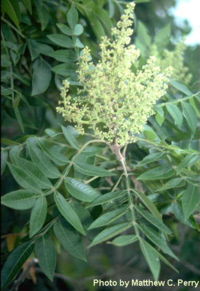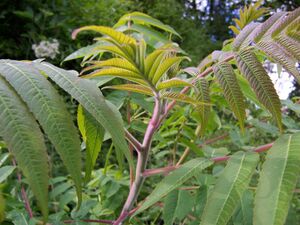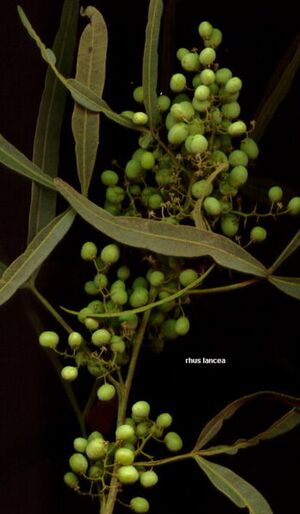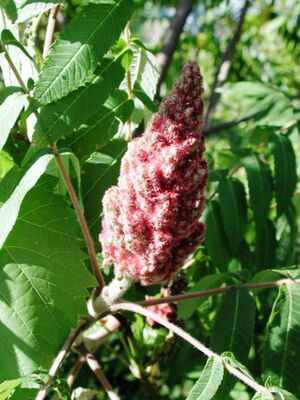Sumac
| subsp. var. | ||||||||||||||||||||||||||||||||||||||||||||||||||||||||
|---|---|---|---|---|---|---|---|---|---|---|---|---|---|---|---|---|---|---|---|---|---|---|---|---|---|---|---|---|---|---|---|---|---|---|---|---|---|---|---|---|---|---|---|---|---|---|---|---|---|---|---|---|---|---|---|---|

|
|
| ||||||||||||||||||||||||||||||||||||||||||||||||||||||
| ||||||||||||||||||||||||||||||||||||||||||||||||||||||||
| Standard Cyclopedia of Horticulture |
|---|
|
{{{1}}} The above text is from the Standard Cyclopedia of Horticulture. It may be out of date, but still contains valuable and interesting information which can be incorporated into the remainder of the article. Click on "Collapse" in the header to hide this text. |
| Sumac {{{status}}} Fossil range: {{{fossil_range}}}
| ||||||||||||||||||||||||||||||||||||||||||||||||||||||||||||||||||
|---|---|---|---|---|---|---|---|---|---|---|---|---|---|---|---|---|---|---|---|---|---|---|---|---|---|---|---|---|---|---|---|---|---|---|---|---|---|---|---|---|---|---|---|---|---|---|---|---|---|---|---|---|---|---|---|---|---|---|---|---|---|---|---|---|---|---|
 Winged Sumac leaves and flowers | ||||||||||||||||||||||||||||||||||||||||||||||||||||||||||||||||||
| Plant Info | ||||||||||||||||||||||||||||||||||||||||||||||||||||||||||||||||||
| ||||||||||||||||||||||||||||||||||||||||||||||||||||||||||||||||||
| Scientific classification | ||||||||||||||||||||||||||||||||||||||||||||||||||||||||||||||||||
| ||||||||||||||||||||||||||||||||||||||||||||||||||||||||||||||||||
| [[{{{diversity_link}}}|Diversity]] | ||||||||||||||||||||||||||||||||||||||||||||||||||||||||||||||||||
| {{{diversity}}} | ||||||||||||||||||||||||||||||||||||||||||||||||||||||||||||||||||
| Binomial name | ||||||||||||||||||||||||||||||||||||||||||||||||||||||||||||||||||
| {{{binomial}}} | ||||||||||||||||||||||||||||||||||||||||||||||||||||||||||||||||||
| Trinomial name | ||||||||||||||||||||||||||||||||||||||||||||||||||||||||||||||||||
| {{{trinomial}}} | ||||||||||||||||||||||||||||||||||||||||||||||||||||||||||||||||||
| Type Species | ||||||||||||||||||||||||||||||||||||||||||||||||||||||||||||||||||
| {{{type_species}}} | ||||||||||||||||||||||||||||||||||||||||||||||||||||||||||||||||||
| Species | ||||||||||||||||||||||||||||||||||||||||||||||||||||||||||||||||||
| About 250 species; see text | ||||||||||||||||||||||||||||||||||||||||||||||||||||||||||||||||||
| [[Image:{{{range_map}}}|{{{range_map_width}}}|]] | ||||||||||||||||||||||||||||||||||||||||||||||||||||||||||||||||||
| Synonyms | ||||||||||||||||||||||||||||||||||||||||||||||||||||||||||||||||||
| {{{synonyms}}} |
Rhus is a genus of approximately 250 species of flowering plants in the family Anacardiaceae. They are commonly called sumac or sumach. Some species (including Poison ivy, poison-oak, and poison sumac), often placed in this genus, are here treated in the genus Toxicodendron, which differs in highly allergenic foliage and grayish-white fruit but is not genetically distinct. The name derives from the Greek name for sumac, rhous.

The genus is found in subtropical and warm temperate regions throughout the world, with the highest diversity in southern Africa.
They are shrubs and small trees growing to 1-10 m tall. The leaves are spirally arranged; they are usually pinnately compound, though some species have trifoliate or simple leaves. The flowers are in dense panicles or spikes 5-30 cm long, each flower very small, creamy white, greenish or red, with five petals. The fruit form dense clusters of reddish drupes called sumac bobs.
Sumac propagates both by seeds, which are spread by birds and other animals through their droppings, and by new sprouts from rhizomes, forming large clonal colonies.
Species
Cultivation and uses
The drupes of the Genus Rhus are harvested, the hairy coating removed and then ground to be used as a spice (a deep red powder with a sour taste) in some Middle Eastern countries, particularly with salads. In North America, the smooth sumac, Rhus glabra, and the staghorn sumac, Rhus typhina, are sometimes used to make a beverage, termed "sumac-ade" or "Indian lemonade" or "rhus juice". This drink is made by soaking the drupes in cool water, rubbing the active principle off the drupes, then straining the liquid through a cotton cloth and sweetening it. Native Americans also used the leaves and berries of the smooth and staghorn sumacs combined with tobacco in traditional smoking mixtures.
Species including the fragrant sumac Rhus aromatica, the littleleaf sumac, R. microphylla, the skunkbush sumac, R. trilobata, the smooth sumac, and the staghorn sumac are grown for ornament, either as the wild type or as cultivars.
The leaves of certain sumacs yield tannin (mostly pyrogallol), a substance used in vegetable tanning. Leather tanned with sumac is flexible, light in weight, and light in color, even bordering on being white.
Dried sumac wood glows under UV lighting (blacklight) Template:Fact.
Mowing of sumac is not a good control measure as the wood is springy resulting in jagged, sharp pointed stumps when mowed. The plant will quickly recover with new growth after mowing. See Nebraska Extension Service publication G97-1319 for suggestions as to control.
See also
- Red za'atar
References
- ↑ Integrated Taxonomic Information Service. "Rhus laurina."
External links
- Southern African species
- RO Moffett. A Revision of Southern African Rhus species FSA (Flora of South Africa) vol 19 (3) Fascicle 1.
- Schmidt, E., Lotter, M., & McCleland, W. (2002). Trees and Shrubs of Mpumalanga and Kruger National Park. Jacana. ISBN 1-919777-30-X.
- List of Southern African indigenous trees
- Sumac Shrubs

